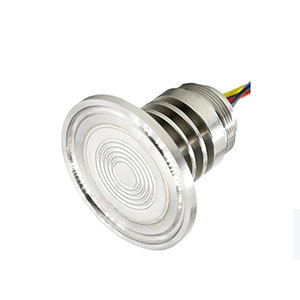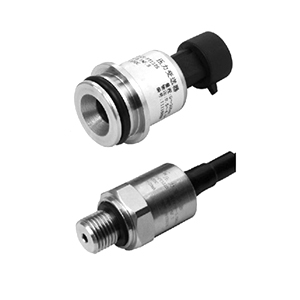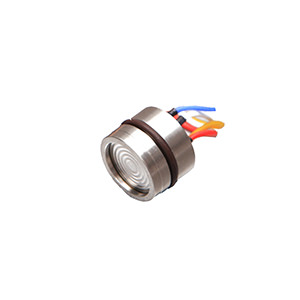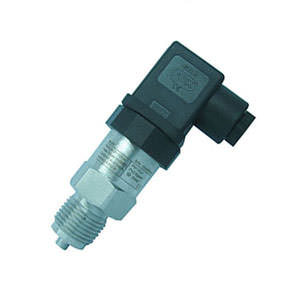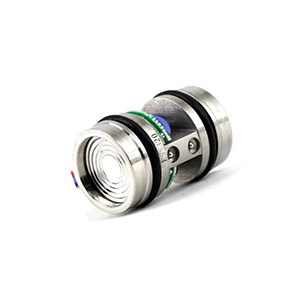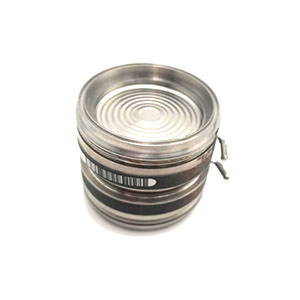The Impact of Temperature Variations on Pressure Measurements
Even though, in today pressure measurement and control system, pressure sensors are integral to these applications, they are susceptible to various external factors that can influence their accuracy, one of the most prominent being temperature variations.
Temperature changes have a two-fold effect on pressure sensor measurements.
First, it influences the mechanical properties of the sensing element itself. For instance, the elasticity and stress-strain relationship of a silicon diaphragm used in MEMS (Micro-Electro-Mechanical Systems) pressure sensors change with temperature. A silicon diaphragm may have a linear stress-strain relationship at 20°C, but as the temperature rises to 60°C, this relationship may become non-linear, thereby leading to inaccurate pressure readings.
Second, it impacts the electronic components (like amplifiers and ADCs) used in the sensor system. For example, the offset and gain of an operational amplifier used in the signal conditioning circuit may drift with temperature.
Depending on the sensor design and material, the effect of temperature can be quite significant. Some sensors may experience a drift of up to 2% of the Full Scale Output (FSO) per degree Celsius of temperature change.
Click to check: How Temperature Causes Pressure Measurement Errors.
Importance of Temperature Compensation for Accurate Readings
To ensure accurate and reliable pressure readings across the operating temperature range, it’s imperative to implement temperature compensation in pressure sensors.
Temperature compensation aims to negate or minimize the impact of temperature variations on sensor output.
A temperature-compensated sensor will provide consistent readings across its specified temperature range.
Without temperature compensation, a pressure sensor may read 100 psi at 20°C, but at 60°C, it might indicate 102 psi, even if the actual pressure has not changed. The sensor would read 100 psi accurately at both temperatures with temperature compensation.
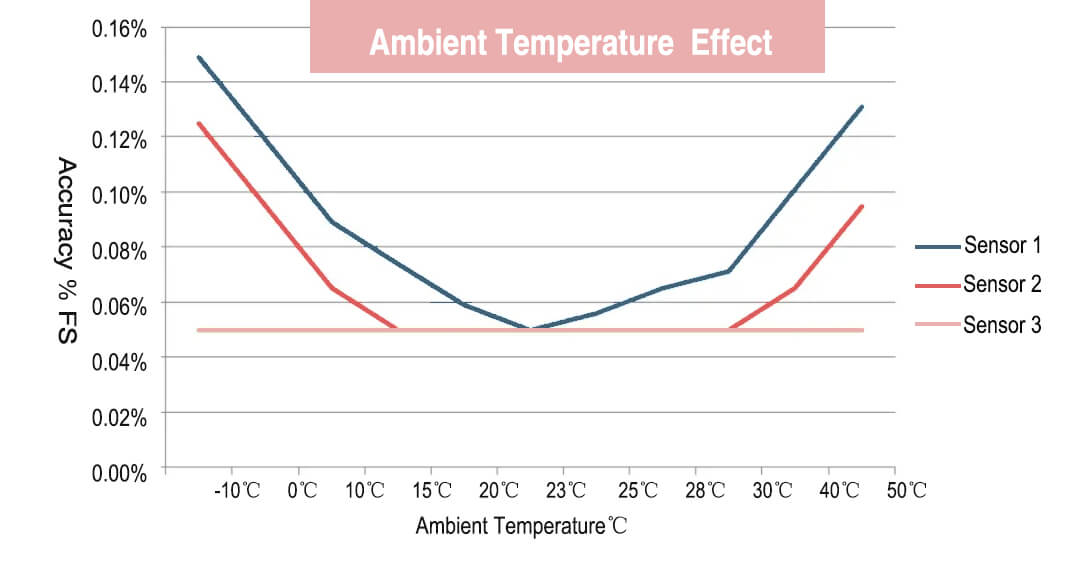
The above graph displays the overall specified accuracy while considering the impact of temperature on pressure gauges. As shown in this example, the absence of temperature compensation ( Sensor 1 ) and the addition of the temperature coefficient specification increase the 0.05% FS accuracy specification by more than three times.
Temperature compensation can be done in two main ways:
- Hardware Compensation: This involves adding components to the sensor system, like a temperature sensor and a compensating circuit. The temperature sensor measures the ambient temperature, and the compensating circuit adjusts the pressure sensor output based on the temperature reading. This method is highly effective but adds complexity and cost to the sensor system.
- Software Compensation: This is done using an algorithm that corrects the pressure readings based on a sensor’s temperature behavior model. The model is typically derived from calibration data gathered at various temperature points. Software compensation is more flexible and cheaper than hardware compensation but requires accurate calibration data.
Pressure Sensor Materials and Their Temperature Characteristics
Pressure sensor performance is inherently tied to the characteristics of the materials they are made from. These materials can respond differently to temperature changes, leading to varying degrees of measurement error. A deeper understanding of these materials and their characteristics can help us make better sensor design and selection choices.
Silicon, the most commonly used material in MEMS pressure sensors, is highly sensitive to temperature changes. It has a temperature coefficient of resistance (TCR) of about 0.36% per °C. This means that the resistance of silicon changes by 0.36% for each degree Celsius change in temperature. In the context of a pressure sensor, this can lead to significant errors if temperature changes are not properly accounted for.
Other materials like stainless steel, ceramics, and various alloys are also used in different types of pressure sensors. These materials generally have lower temperature sensitivity than silicon, but they also offer lower linearity, hysteresis, and repeatability performance.
Click to check more: Pressure Sensor Material
How Temperature Can Cause Measurement Errors
As we’ve mentioned earlier, temperature changes can influence a pressure sensor’s mechanical and electronic components, leading to measurement errors.
For instance, an increase in temperature in a silicon-based pressure sensor can cause the silicon diaphragm to become less stiff. This may result in a higher output signal for a given pressure, causing a positive measurement error.
Similarly, in the sensor’s signal conditioning circuit, the temperature can cause the offset and gain of the operational amplifier to drift. This will affect the final output of the sensor system, introducing additional error into the pressure measurement.
Depending on the severity of these effects and the required accuracy of the application, these temperature-induced errors can be quite problematic.
However, most of above mentioned affect can be greatly alleviated via proper temperature compensation.
To demonstrate the actual impact of temperature compensation, we conducted a test using a pressure sensor without temperature compensation in a temperature chamber. The sensor was subjected to pressure testing ranging from 0 to 580 psi (0 to 40 bar) across the temperature range of 0°C to 40°C.
We also performed the same test using a temperature compensated sensor.
As anticipated, the influence of environmental temperature becomes more pronounced as the pressure increases. The following chart compares the non-temperature compensated sensor with the temperature compensated sensor.
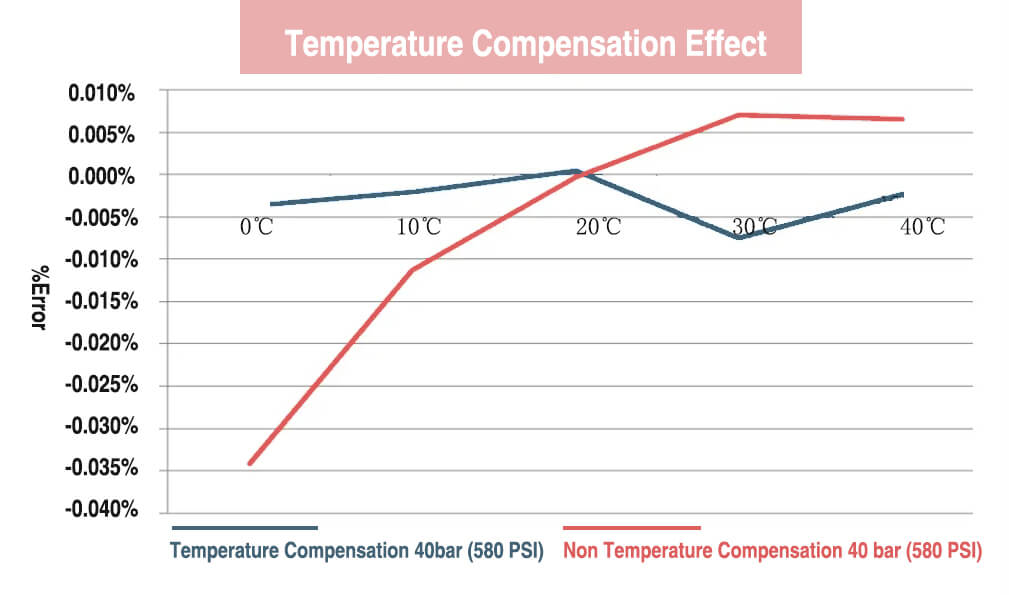
Click to check: How Temperature Causes Pressure Measurement Errors
Temperature Compensation Techniques: An In-Depth Analysis
Analog Compensation Methods, Including Signal Conditioning Circuits
Analog compensation methods are often employed to counteract the effects of temperature variations on pressure sensor output. This typically involves a temperature sensor and a signal conditioning circuit that adjusts the pressure sensor output based on the temperature reading.
A common example is a Wheatstone Bridge Circuit with a resistive temperature detector (RTD) incorporated into it. The RTD changes resistance with temperature, which in turn adjusts the output of the Wheatstone bridge to compensate for temperature effects.
Another method is using a compensation amplifier. This circuit includes an operational amplifier with a gain that varies based on the temperature. The varying gain helps to counteract the temperature effects on the pressure sensor.
These analog compensation techniques can be quite effective, but they do increase the complexity and cost of the sensor system. Furthermore, they usually require careful calibration to ensure accuracy across the temperature range.
Digital Compensation Using Microcontrollers and Software Algorithms
Digital compensation is a more flexible and potentially cheaper method for temperature compensation. It involves using a microcontroller to process the pressure sensor output and apply a correction based on a sensor’s temperature behavior model.
The model is usually derived from calibration data gathered at various temperature points. For instance, the sensor could be calibrated at 0°C, 25°C, and 50°C, and a mathematical model (like a polynomial or lookup table) would be fitted to this data.
The microcontroller then uses this model to correct the pressure reading for any given temperature. For example, if the actual temperature is 30°C, the microcontroller would interpolate between the calibration points for 25°C and 50°C to determine the correct compensation factor.
Digital compensation requires accurate calibration data, but it can be easily adjustable for different sensor behaviors or application requirements.
Hybrid Approaches for Combining the Benefits of Both Analog and Digital Techniques
For certain applications, the best solution may be a hybrid approach that combines the benefits of both analog and digital techniques. This could involve an analog compensation circuit to handle large temperature effects, followed by a microcontroller for fine-tuning the compensation based on specific calibration data.
For example, an analog circuit could be used to compensate for the bulk temperature effects on the sensor’s material properties. Then, a microcontroller could apply a software algorithm to correct for smaller, more complex temperature effects that vary based on factors like pressure and time.
A hybrid approach can provide the robust performance of analog compensation and digital compensation’s flexibility and adaptability. However, it requires careful design and calibration to ensure that the two methods work synergistically.
| Key Point | Details & Numbers |
|---|---|
| Analog Compensation | Uses elements like Wheatstone bridge circuit and compensation amplifier, Can increase complexity and cost, Requires careful calibration |
| Example of Analog Compensation | RTD in Wheatstone Bridge circuit: resistance changes with temperature, compensating for temperature effects |
| Digital Compensation | Employs microcontroller and software algorithm based on calibration data, Requires accurate calibration data, Highly adjustable and adaptable |
| Example of Digital Compensation | Sensor calibrated at 0°C, 25°C, 50°C: Microcontroller uses mathematical model to interpolate correct compensation factor |
| Hybrid Approach | Blends analog and digital techniques, Affords robust performance and flexibility, Requires meticulous design and calibration |
| Example of Hybrid Approach | Analog circuit compensates for bulk temperature effects on sensor's material properties, Microcontroller corrects for smaller, more complex temperature effects |
Choosing the Right Temperature Compensation Method for Your Application
Considering Application-Specific Requirements and Constraints
When it comes to selecting the ideal temperature compensation method for your pressure sensor application, a comprehensive understanding of your specific requirements and constraints is critical.
You’ll need to evaluate several factors:
- Accuracy Requirements: Does your application demand highly accurate pressure measurements? If so, a robust compensation method, possibly even a hybrid approach, may be necessary.
- Temperature Range: The wider the operating temperature range of your application, the more crucial a reliable compensation technique becomes.
- Cost Constraints: Analog methods can add to the cost due to additional components and increased complexity, while digital methods can be more cost-effective, especially for large-scale manufacturing.
- Space Limitations: If the sensor system needs to fit within a compact space, this may limit the complexity of the hardware you can add for analog compensation.
Evaluating the Trade-offs Between Different Compensation Methods
- Analog Compensation: Although it can offer effective compensation and high performance, it can add to the complexity and cost of the sensor system, and it requires careful calibration.
- Digital Compensation: It provides flexibility and is potentially cheaper, but it relies heavily on accurate calibration data. Further, it requires sufficient processing power, which could be a limiting factor in some systems.
- Hybrid Approach: A combination of analog and digital methods can yield excellent performance and adaptability, but it necessitates careful design and calibration to ensure that the two methods work synergistically.
Understanding these trade-offs is crucial for making an informed decision about the best compensation method for your application.
Case Examples of Successful Temperature Compensation Strategies in Various Industries
Automotive Industry: In a tire pressure monitoring system (TPMS), temperature compensation is crucial as tire temperature can vary significantly during use. A hybrid approach might be utilized here. An analog circuit handles the bulk temperature changes due to the heat generated from driving, and a microcontroller applies fine adjustments based on the specific temperature-pressure relationship of the tire.
Medical Sector: In blood pressure monitors, accuracy is paramount. Since these devices operate in a relatively controlled temperature environment, digital compensation could be an ideal choice. It allows for high accuracy without adding much complexity or cost.
Industrial Control Systems: In applications like HVAC systems, where both cost and space are major constraints, digital compensation could be the preferred method. A microcontroller already present for control tasks can also handle temperature compensation, making it a cost-effective solution.
Innovations in Temperature Compensation for Pressure Sensors
1. MEMS Technology and its Impact on Temperature Compensation
Micro-Electro-Mechanical Systems (MEMS) technology has been a game-changer in the realm of pressure sensors and temperature compensation. MEMS pressure sensors, which are microfabricated devices, offer several advantages that help improve temperature compensation.
Firstly, the small size of MEMS sensors inherently improves their thermal response because of a smaller thermal mass, which enables the device to reach thermal equilibrium quickly. This leads to less thermal drift and more accurate temperature compensation.
Secondly, MEMS technology allows for the integration of pressure sensors with on-chip temperature sensors. The close proximity of these two sensors means the temperature sensor can more accurately track the temperature experienced by the pressure sensor, leading to better compensation performance.
Furthermore, MEMS technology also facilitates on-chip signal processing, which can include digital temperature compensation algorithms. This integration results in more compact and cost-effective sensor solutions.
2. Novel Materials and Sensor Designs for Improved Thermal Stability
New materials and sensor designs are continually being explored to improve the thermal stability of pressure sensors.
For example, certain alloys and ceramic materials exhibit particularly low thermal expansion coefficients, meaning their dimensions (and thus their performance) change very little with temperature. Incorporating these materials into sensor designs can help minimize the temperature effects on sensor performance.
Moreover, novel sensor designs, such as differential pressure sensor designs, can inherently compensate for temperature effects. In these designs, the measurement is based on the difference in pressure between two sensor elements, which means that common-mode temperature effects cancel out.
3. Cutting-Edge Research and Advancements in Temperature Compensation Techniques
Research is always ongoing to further enhance temperature compensation techniques. This includes developing new algorithms for digital compensation, exploring innovative hybrid compensation strategies, and investigating machine learning approaches to model the temperature behavior of sensors more accurately.
For instance, advanced machine learning algorithms, like neural networks, can potentially model complex, non-linear temperature behaviors that are hard to capture with traditional compensation algorithms. These machine-learning models can be trained on calibration data and then used to perform highly accurate temperature compensation.

